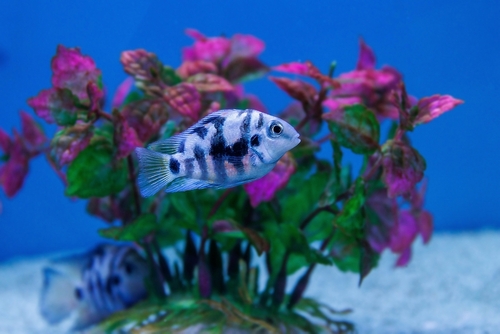Your polar blue parrot cichlid might look like it needs a friend, but are you sure which will be best? We’ll help you decide with our list of the 15 best polar blue parrot cichlid tank mates!
The best polar blue parrot cichlid tank mates are usually fish that have a temperament which can withstand interactions with the cichlid. On top of that, tank mates need to be big enough in length to avoid winding up as the cichlid’s next meal, but also capable of living healthy in the same habitat.
We’ll show you our list of the 15 best polar blue parrot cichlid tank mates that are known in aquarium circles. This information should include what those fish have that make them such great potential companions, and a little additional advice on how to care for them.
Contents
Polar Blue Parrot Cichlid Tank Mates – What You Need to Know
Everything you need to consider about your polar blue parrot cichlid can help you narrow down which tank mates will work best.
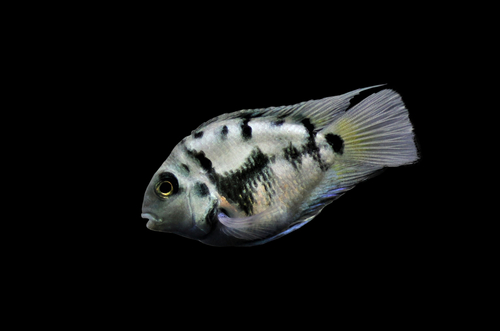
Temperament
The temper of a polar blue parrot cichlid is slightly different from most other cichlids. What we mean is: they aren’t bullies! Generally, these beautiful fish are peaceful and won’t work hard to cause trouble. That said, if there isn’t enough room or if another fish is bothering them, they aren’t afraid to get aggressive.
What you’re looking for are tank mates who are of the same mentality, neither being easily bullied nor looking for a fight themselves.
Size
A polar blue parrot cichlid is around 3 to 4 inches in length, and sometimes grows to 8 inches if cared for well enough. Though they don’t go hunting for trouble, you’ll want fish that are no smaller than 3 inches or very fast to avoid them being swallowed by the polar blue parrot cichlid.
Competition
A polar blue parrot cichlid eats all manner of food, like veggies, brine shrimp, pellets, feeder fish, and much more. They need to face little competition for their nutrients; get fish that don’t eat at the exact same time, or prefer their food on the bottom of the tank.
Parameters & Tank Setup
These cichlids need a tank that is at least 30 gallons (100L) minimum in order to keep their cool. They prefer a temperature range of 76F to 82F (24C-27C). This is important, because which ever tank mates you decide upon will need to be comfortable in the same temperature range.
Best Polar Blue Parrot Cichlid Tank Mates
We can now move into discussing our list of the best picks for your cichlid’s company.
- Golden Severum
- Salvini Cichlid
- Silver Dollar Fish
- Tiger Barb
- Bala Shark
- Oscar Fish
- Kuhli Loach
- Zebra Danio
- Clown Loach
- Firemouth Cichlid
- Bristlenose Pleco
- Rainbow Krib
- Rosy Barb
- Giraffe Catfish
- Blood Parrot Fish
It should be noted though that of the above 15 listed, they will not all necessarily be compatible with each other. As an example Oscars will do well with the polar parrots, however adding Zebra Danio will just end up been a tasty snack for the Oscars.
Below, you’ll find the information on why each of our picks made this list.
You will also like these other top posts in this category:
1. Golden Severum
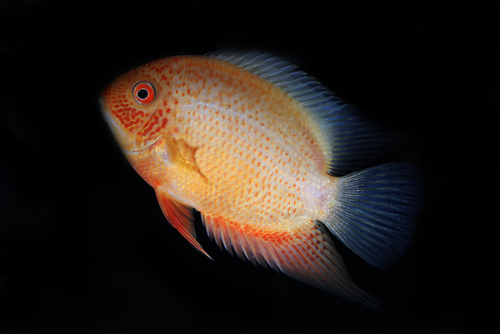
- Scientific Name: Heros severus
- Adult Size: 7 and a half inches
- Compatible With: Polar Blue Parrot Cichlid
- Care Level: Intermediate Difficulty
- Origin: Rio Negro Basin
The golden severum is quite a looker in any fish tank. It is shaped traditionally, with such a sunny, pale coloration that you would be surprised to find it has an aggressive temperament.
That being said, although the golden severum is likely to test the patience of any other fish smaller than itself, it will probably stop bothering your polar blue parrot cichlid once it realizes that the arctic-colored fish can’t be pushed around easily!
Pros of keeping with Polar Blue Parrot Cichlid:
- Matching temperaments
Cons of keeping with Polar Blue Parrot Cichlid :
- Some chance of aggression
2. Salvini Cichlid
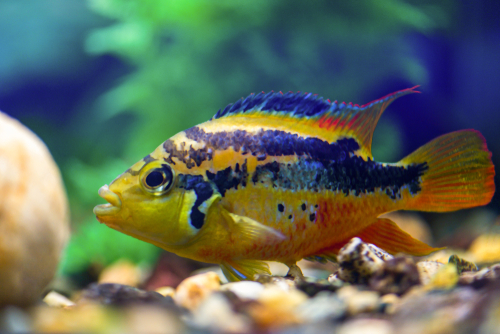
- Scientific Name: Cichlasoma salvini
- Adult Size: 9 inches
- Compatible With: Polar Blue Parrot Cichlid
- Care Level: Difficult
- Origin: Central American Waters
If you have a salvini cichlid, or a “yellowbelly cichlid,” as they are sometimes called, you will be in for a very engaging experience. Not only is this cichlid quite beautiful, with a whole host of rainbow colors striped with striking black marks, but it’s large size and semi-aggressive nature will keep you on your toes.
That being said, one fish you won’t have to worry about in company with the Salvini cichlid is the polar blue parrot cichlid. As long as there is enough space for both fish to have their own safe zone, they will likely test each other’s bravery once or twice and then coexist peacefully.
Pros of keeping with Polar Blue Parrot Cichlid:
- Matching temperaments
Cons of keeping with Polar Blue Parrot Cichlid :
- Some chance of aggression
3. Silver Dollar Fish
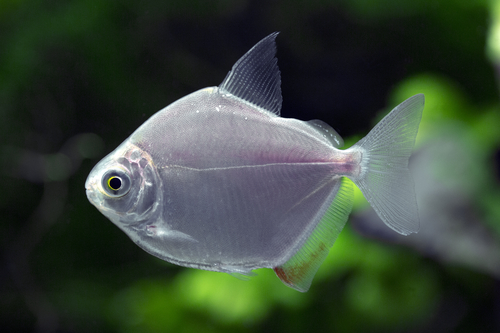
- Scientific Name: Metynnis argenteus
- Adult Size: 6 inches
- Compatible With: Polar Blue Parrot Cichlid
- Care Level: Intermediate difficulty
- Origin: Brazil
These fish are some of the largest you can get for aquariums, but also some of the gentlest in temperament. They enjoy being around other fish, but won’t go out of their way to mess with shy tank mates.
Silver Dollar fish are so called because of their shining silver bodies, which are disc-shaped. They enjoy being in schools and eat veggies, so even food competition will be kept to a minimum!
Pros of keeping with Polar Blue Parrot Cichlid:
- No food competition
- Not aggressive
Cons of keeping with Polar Blue Parrot Cichlid :
- None
4. Tiger Barb
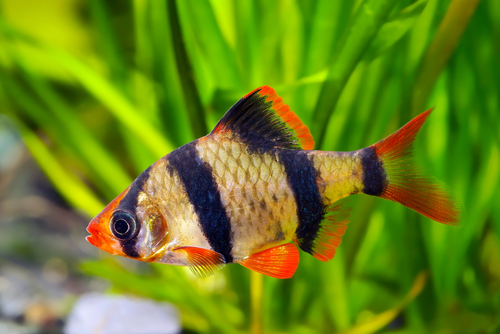
- Scientific Name: Barbus tetrazona
- Adult Size: 3 inches
- Compatible With: Polar Blue Parrot Cichlid
- Care Level: Beginner or Intermediate
- Origin: Sumatra, Borneo, Indonesia
Tiger Barbs are some of the most perfect tank mates any aquarium enthusiasts can get. Although they are smaller than the polar blue parrot cichlid, they are just big and fast enough to avoid being in danger of getting eaten.
Tiger barbs are playful with groups of one another. They are peach-colored with black stripes.
Pros of keeping with Polar Blue Parrot Cichlid:
- Not aggressive
- No food competition
Cons of keeping with Polar Blue Parrot Cichlid :
- None
5. Bala Shark
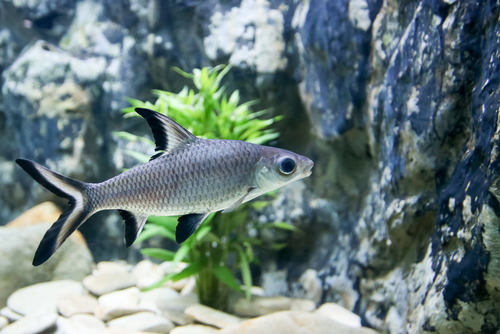
- Scientific Name: Balantiocheilos melanopterus
- Adult Size: 13 inches
- Compatible With: Polar Blue Parrot Cichlid
- Care Level: Intermediate or Beginner
- Origin: Southeast Asian Water
Bala Sharks are named mainly for their shape, which is horizontally aligned with forked tails much like a Great White Shark might be. However, these fish have also been called minnows.
They’re typically silver in color and the easiest part of caring for them is their diverse diet. Bear in mind that much smaller fish can be eaten by the Bala shark when it reaches full size; luckily, polar blue parrot cichlids are much too brave and just big enough to avoid this.
Pros of keeping with Polar Blue Parrot Cichlid:
- Not aggressive
- No food competition
Cons of keeping with Polar Blue Parrot Cichlid :
- None
6. Oscar Fish
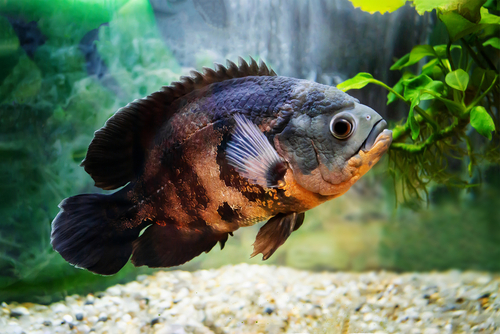
- Scientific Name: Astronotus ocellatus
- Adult Size: 14 inches
- Compatible With: Polar Blue Parrot Cichlid
- Care Level: Difficult
- Origin: South America
The oscar fish might be very large, as well as carnivorous and fine with starting fights, but it’s beauty can make you forget these factors. Oscar fish are large, but mottled with brown and gold, which is accented by neon-orange spots and long, soft-looking fins.
Though they can be pushy, Oscar Fish work well with blue parrot cichlids because their temperaments are evenly matched; the Oscar fish will learn quickly that blue parrot cichlids won’t tolerate being bullied, and with enough space, each fish will keep to itself.
Pros of keeping with Polar Blue Parrot Cichlid:
- Little food competition
Cons of keeping with Polar Blue Parrot Cichlid :
- Some chance of aggression
7. Kuhli Loach

- Scientific Name: Pangio kuhlii
- Adult Size: 4 inches
- Compatible With: Polar Blue Parrot Cichlid
- Care Level: Beginner
- Origin: Southeast Asia
This omnivorous fish is sometimes mistaken for an eel thanks to its long, banana-like shape. It will not only provide visual difference for your tank, but makes a great companion for cichlids because of its even temper and preference for staying on the bottom of the tank.
Polar blue parrot cichlids will look visually compelling next to the warm colors of this loach. The kuhli loach is mottled with gold and brown, which is why it is sometimes named after a leopard.
Pros of keeping with Polar Blue Parrot Cichlid:
- Not aggressive
- No food competition
Cons of keeping with Polar Blue Parrot Cichlid :
- None
8. Zebra Danio

- Scientific Name: Danio rerio
- Adult Size: 2 inches
- Compatible With: Polar Blue Parrot Cichlid
- Care Level: Beginner
- Origin: Eastern India
This little slip of color is a fish that has been delighting community tanks for a long time. Zebra danios are very small, but because they usually are bought in groups of three or four, they work well using strength in numbers and speed to deter bigger fish like the polar blue parrot cichlid from preying on them.
These little fish are named for their stripes. These are usually navy blue and cover the warmer, peachier coloring of the zebra danio.
Pros of keeping with Polar Blue Parrot Cichlid:
- Not aggressive
- No food competition
- Strength in numbers
Cons of keeping with Polar Blue Parrot Cichlid :
- Some chance of being eaten
9. Clown Loach
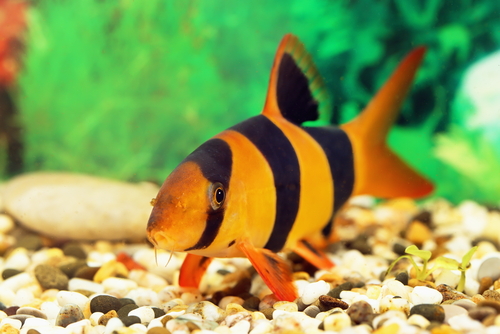
- Scientific Name: Botia macracantha
- Adult Size: 12 inches
- Compatible With: Polar Blue Parrot Cichlid
- Care Level: Intermediately Difficult
- Origin: Indonesia
The clown loach is peaceable and fun to watch. It stays near the bottom of the tank, but it likes to school with a few others. It will pose no threat of hassle to the polar blue parrot cichlid.
Clown loaches bear some resemblance to classic clownfish with orange colors, but black stripes instead of white. They also have whiskers.
Pros of keeping with Polar Blue Parrot Cichlid:
- Not aggressive
- No food competition
Cons of keeping with Polar Blue Parrot Cichlid :
- None
10. Firemouth Cichlid
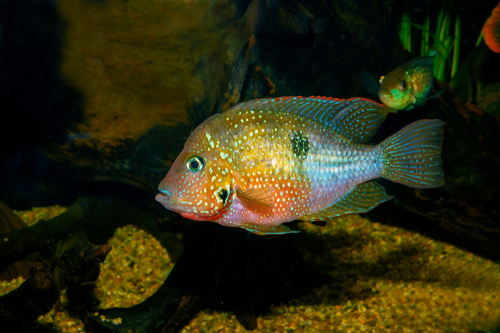
- Scientific Name: Thorichthys meeki
- Adult Size: 7 inches
- Compatible With: Polar Blue Parrot Cichlid
- Care Level: Beginner
- Origin: Singapore, the Philippines, Australia, Israel
This species of cichlid has almost the exact same tendency toward semi-aggression as the polar blue parrot cichlid; in the cases where tanks are big enough and there are enough obstacles to keep the fish apart, they usually cancel each other’s tendency toward fighting out.
Firemouth cichlids are similar to river salmon in some color aspects. They are mostly muddy silver with pink-orange bellies and lips. They have faint electric blue markings on their fins and tail, too.
Pros of keeping with Polar Blue Parrot Cichlid:
- Matching temperaments
Cons of keeping with Polar Blue Parrot Cichlid :
- Some chance of aggression
11. Bristlenose Pleco
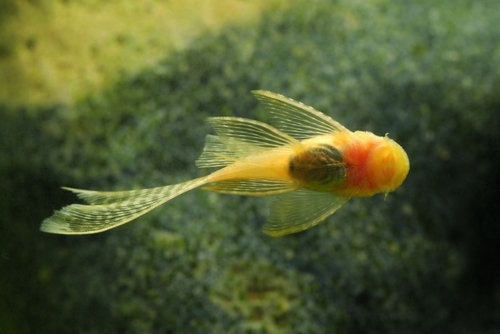
- Scientific Name: Ancistrus cirrhosus
- Adult Size: 5 inches
- Compatible With: Polar Blue Parrot Cichlid
- Care Level: Intermediate Difficulty
- Origin: Amazon Basin Waters
This fuzzy-faced fish is so delightful to look at! The pleco stays at the bottom of the tank and bothers nobody, making it great for your polar blue parrot cichlid.
On top of that, you’ll get to enjoy the bristlenose pleco’s other striking features, like its blue eyes or gold-speckled body.
Pros of keeping with Polar Blue Parrot Cichlid:
- Not aggressive
- Cleans up tank floor
Cons of keeping with Polar Blue Parrot Cichlid :
- None
12. Rainbow Krib

- Scientific Name: Pelvicachromis pulcher
- Adult Size: 4 inches
- Compatible With: Polar Blue Parrot Cichlid
- Care Level: Beginner
- Origin: African waters
The rainbow crip is also called the king cichlid for its royal coloration. It is one of the few cichlid species that are largely peaceful.
It will be a very gentle tank mate for your blue parrot cichlid. These fish are pretty, with pink bellies, dark heads striped with white, and fins accented with fire colors and offset by dark spots.
Pros of keeping with Polar Blue Parrot Cichlid:
- Not aggressive
- No food competition
Cons of keeping with Polar Blue Parrot Cichlid :
- None
13. Rosy Barb
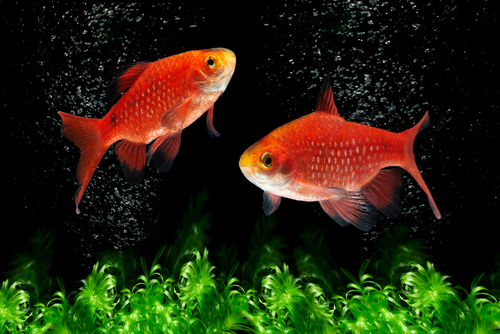
- Scientific Name: Puntius conchonius
- Adult Size: 6 inches
- Compatible With: Polar Blue Parrot Cichlid
- Care Level: Intermediate
- Origin: India
This is a rock-star-looking fish, with a spiky dorsal fin that could remind someone of a mohawk hairstyle! The rosy barb is named after its rusty red or orange colors.
This barb is quite active with others, but peaceful ultimately. This means it won’t bother your semi-aggressive polar blue parrot cichlid.
Pros of keeping with Polar Blue Parrot Cichlid:
- Not aggressive
- No food competition
Cons of keeping with Polar Blue Parrot Cichlid :
- none
14. Giraffe Catfish

- Scientific Name: Auchenoglanis occidentalis
- Adult Size: 36 inches
- Compatible With: Polar Blue Parrot Cichlid
- Care Level: Difficult
- Origin: Congo River Waters
Giraffe catfish are named for their mottled brown bodies, which, if you look closely, resemble the spots of a giraffe. Otherwise, they’re very fun to look at, with forward-facing whiskers on the end of long, narrow faces, and rounded fins.
Giraffe catfish will stay on the bottom of the tank. Though they are gentle, the downside is that they can reach very large sizes and need to be accommodated in big tanks, not because they’ll start fights, but because your polar blue parrot cichlid will if it feels crowded!
Pros of keeping with Polar Blue Parrot Cichlid:
- Not aggressive
- Cleans up tank floor
Cons of keeping with Polar Blue Parrot Cichlid :
- None
15. Blood Parrot Fish
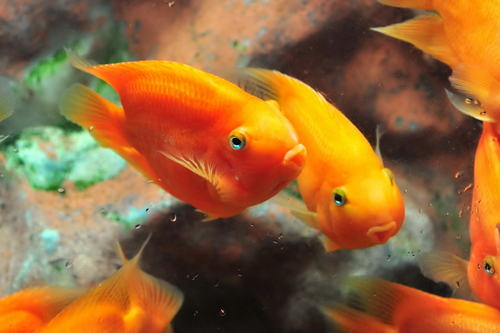
- Scientific Name: Vieja synspilum and Amphilophus citrinellus
- Adult Size: 8 inches
- Compatible With: Polar Blue Parrot Cichlid
- Care Level: Intermediate Difficulty
- Origin: Human-made
Blood Parrot fish are also called bloody parrot cichlids; they are a hybrid of two other kinds of cichlids, namely the red devil and the midas cichlids. They are funny to make eye contact with, having pursed lips and bulging eyes, while their fins are beautifully segmented. Their overall color is usually red to orange.
This fish can be compatible, mainly with other cichlids, like the blue parrot, as long as there are enough hiding places and their tank mates don’t come looking for trouble. They also need good filtration, which can be tricky to master.
Pros of keeping with Polar Blue Parrot Cichlid:
- Matching temperaments
Cons of keeping with Polar Blue Parrot Cichlid :
- Some food competition
In Conclusion
To conclude, the 15 best polar blue parrot cichlid tank mates are other species of fish that can not only handle, but thrive, in similar conditions to the Polar Blue Cichlid. With fish that stay in their own area and plenty of space, you’ll have no trouble finding good companions!
FAQs

Some of the most frequently asked questions about polar blue cichlids include:
How Long Do Polar Parrot Fish Live For?
How long do these fascinating fish typically live? Well, polar blue parrot fish boast a lifespan of approximately 5-10 years. Factors influencing their longevity include the aquarium’s water parameters, diet, genetic factors, and the overall quality of their environment.
For a longer and healthier life, ensure excellent water conditions and a nutritious diet. This not only extends their lifespan but also promotes a serene and comfortable habitat.
What Is the Ideal Aquarium Size for Parrot Cichlids?
The space your polar blue parrot fish require depends on the aquarium size. In a 30-gallon tank, a couple of polar parrots should thrive comfortably. However, for a larger group, consider a spacious 75-gallon tank to minimize territorial disputes and provide ample swimming space.
Remember, these cichlids enjoy companionship, so a well-stocked tank with appropriate polar blue parrot cichlid tank mates is ideal for their well-being.
What Is the Best Feed for Polar Parrot Fish?
While polar parrot cichlids have a diverse dietary palate, it’s crucial to choose their food wisely. Given their unique body shape, they prefer snacks they can consume and digest easily.
Opt for lighter, crunchy foods. Bloodworms, brine shrimps, feeder fish, crustaceans, flakes, and blanched veggies are excellent choices. To maintain their vibrant coloration, supplement their diet with beta-carotene-rich feeds.
What Aquarium Substrate Is Best for Polar Blue Parrot Cichlids?
The preferred substrate for polar blue parrot cichlids varies with age, but generally, they thrive better on finer substrates. This allows for easier swimming and a more comfortable environment.
However, if you’re breeding, consider adding some rocks for egg support. Be mindful of the quantity, as excessive rocks can restrict the movement of these active swimmers.
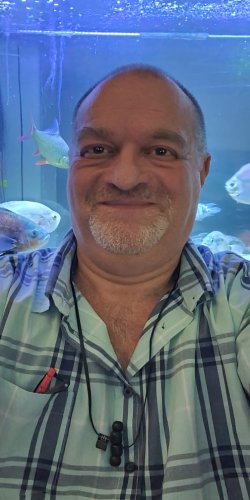
Veteran fish keeper and keen hobbyist with a serious case of MTS. My midlife crisis was the establishment of a fish room, much to my wife’s horror. Little does she know it could be worse!!


